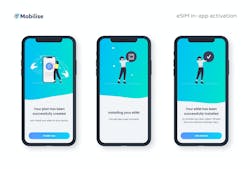Latest from Cybersecurity
A Low-Code Future for Telecom
How can low-code/no-code technologies enhance the evolution of telcos? Hamish White, founder and CEO of Mobilise explains.
Before we start, I hear you say: What are low-code/no-code (LC/NC) platforms? These platforms allow for rapid delivery of business applications, requiring minimal hand-coding and upfront investment in setup, training, and deployment. Instead of writing code, low-code development employs a visual modelling platform to define data models, user interfaces, business logic, and more. Historically, when looking to install an IT system, telcos had to choose between building a new system in-house or purchasing one from a third party. However, both these options come with their own set of drawbacks.
Designing a system in-house ensures it meets the telco’s needs but requires significant resources and internal technical knowledge. While an external partner can fill out a skills gap, solutions aren’t custom, and their expertise might not exactly fit the needs of the company.
Enter LC/NC
More recently, however, an alternative emerged and it is now one of the top tech trends in the telecom industry. LC/NC solutions are designed to make it simpler for companies to design, build and launch applications quickly. Rather than using complex coding languages, low-code platforms use visual interfaces with simple logic and drag-and-drop features, intuitive enough to be used by almost anyone working within a telco, not just those with coding knowledge.
In addition to offering user-friendly interfaces to simplify the process of building complex solutions, LC/NC platforms can simplify integration and customization processes, enabling the rapid delivery of business applications and accelerating innovation development. By utilizing low-code Business Support Systems (BSS), telecom operators can create unique digital experiences, swiftly launch new products, adapt to market needs, and maintain their competitive edge.
The Benefits of LC/NC
There are additional benefits LC/NC platforms can bring to telcos, too. As well as reducing the time required for developing BSS and supporting quicker response times, LC/NC can help plug telecom’s ongoing talent gap.
The development of traditional BSS deployment was often limited to IT professionals. However, with LC/NC platforms, everyone within the business—from business analysts and product managers to other non-technical stakeholders—is able to actively participate in the development process. This enhances collaboration and ensures that those closest to business requirements can directly contribute to system design.
This is particularly important given the ongoing shortage of IT talent within the global workforce. There are around 40 million technical jobs unfulfilled due to a lack of skilled talent, and this number is expected to reach 85.2 million by 2030.1 There is, and increasingly will be, a more desperate need to leverage non-technical talent to manage business systems without coding knowledge.
With LC/NC, telcos can avoid having to enter the fight for technical talent from such a limited pool, as it’s easier to train existing employees to use it. In fact, results have shown that 70% of low-code users with no prior experience2 of using low-code platforms learned low-code in less than one month.
LC/NC Telco Applications
So, what does this all mean for telco? Let me provide you with an example of what we can do with Mobilise’s Business Insights analytics module. With this module, you can create responsive or predictive dashboards and workspaces, add “widgets” to existing pages, and create links to other reporting modules. This platform is designed to be a no-code platform for most users, but you can also add code to create new visualizations or add extra controls. Technically speaking, it's also a low-code platform.
An alternative example could be a CRM interface, which could provide users with complete control over the layout of pages. Including, for example, the ability to add, move and remove fields as needed, as well as the ability to add custom business rules and validations, images, and user instructions. These are all tasks that traditionally would have required a change request and code changes by developers but can now be accomplished by admin users through a no-code platform.
With an increase in consumer and industry aptitude for digital, digital platforms often need to undergo frequent changes, in order to meet the evolving needs of their customers. LC/NC applications give telcos the agility and scalability they need to meet these needs.
One recent addition to telecoms’ digital ecosystem is eSIM3 technology. While it’s been around for a while, receiving accreditation from the GSMA for consumer use cases in 2016, only in the last few years have we started to see widespread adoption. Most notably due to Apple launching its eSIM-only iPhone in the U.S. market.
This eSIM technology enables telcos to digitalize one of the final steps of the customer journey. Instead of handling the logistics of deploying plastic SIM cards, which adds an extra layer of complexity to the customer’s onboarding journey, customers can simply download over-the-air network credentials to authenticate their subscription via a mobile application in a matter of seconds, rather than days. From the customer’s perspective, this enables completely frictionless onboarding. But for telcos without the appropriate technical know-how or system, it can be a challenge to implement.
On the back end, to onboard a customer through an in-app eSIM subscription, subscriber provisioning, stock management and Know Your Customer (KYC) is all handled by application programming interfaces (APIs). APIs are developed for specific purposes, but once created, they are reusable, allowing an organization to create ecosystems of applications that are modular, purposeful, and reusable. But if you don’t have the resources in-house to do this, offering eSIM services in this way feels impossible.
LC/NC BSS
While LC/NC BSS might at first appear like just a bunch of acronyms, the example of eSIM shows how LC/NC benefits telcos of all sizes to keep up with market leaders. Mobilise’s HERO BSS platform4 is an example of this.
The HERO platform provides telcos with a fully digital platform, to offer customers a simple, fully digital onboarding process with all the required APIs included. One module of HERO is eSIM as a Service, which enables telcos to launch eSIM capabilities quickly and with minimal costs. It provides the telco with a mobile application and website, designed to enhance customer experience with a variety of additional self-care features, including account management, purchasing, loyalty schemes and access to customer support.
Technologies that enable more efficient operations and meet customer expectations are key to a successful telco. Digitalization might sound daunting, especially with a lack of knowledge or experience, but taking advantage of tools like LC/NC can make the process simpler and more manageable, even with little coding knowledge.
References
-
Is There A Developer Shortage? https://www.forbes.com/sites/forbestechcouncil/2021/06/08/is-there-a-developer-shortage-yes-but-the-problem-is-more-complicated-than-it-looks
-
4 Low-Code Stats Business Leaders & Developers Need to Know, https://www.mendix.com/blog/infographic-low-code-application-development-trends/
-
eSIM, https://www.mobiliseglobal.com/white-label-esim-app/
-
HERO BSS Platform, https://www.mobiliseglobal.com/hero/

Hamish White | CEO, Mobilise
Hamish White is CEO of telecoms software provider Mobilise. He has more than 20 years of experience in supporting Tier 1 & Tier 2 International Telecommunications Operators. For more information, email [email protected] or visit www.mobileseglobal.com. Follow Mobilise on LinkedIn, Twitter, Facebook, and Instagram.





